In 1990, Satoshi Tajiri pitched Capsule Monsters to Nintendo. Shigeru Miyamoto was very impressed with Tajiri’s previous work and became his mentor, so Capumon was approved and the initial release date was set for December 1991. During the first year of production, Game Freak likely produced several prototypes and demos, but development was difficult and irregular, as Tajiri was also developing other games in parallel (Yoshi) to finance the production. Furthermore, most of the team’s energies went into developing a satisfying trading mechanic, which was the core factor of the game, and Capsule Monsters was far from finished at the end of 1991. Luckily Yoshi‘s sales exceeded expectations and Game Freak could resume production at a calmer pace.
| ⇐ | INTRO | P1 | P2 | P3 | P4 | P5 | ⇒ |
| MissingNo. OVERVIEW | LOST POKÉMON OVERVIEW | ||||||
This short and scarcely documented hiatus between the end of 1991/mid-1992 may also explain the re-indexing of the first 37 Pokémon that we hypothesized to have occurred in P1. This reorganization probably took place as soon as the games’ development resumed.
Between the 1991 deadline and the manga poll (speculatively dated late 1992/early 1993), Game Freak realized that the trademark conflict with the “Capsule Kaiju” from Ultraseven and re-named the project “Pocket Monsters“, Pokémon for short.

PERIOD 2
Period 2 (ID 038-081, Kadabra – MissingNo.) is probably dateable as taking place between 1992-1993: from the moment when production resumed after the December 1991 deadline, up to Atsuko Nishida’s arrival. Motofumi Fujiwara and Shigeki Morimoto join the Pokémon team during this time, adding a distinct new flavour to the roster. The monsters that appeared in the Capsule Monsters booklet are practically absent from now on.
We can split P2 into four patterns. It may seem a bit too specific, but some external evidence suggests to do so:
- Period 2a (038-053, Kadabra – Electabuzz) – battle archetypes and elemental creatures, mostly fantastic and bipedal.
- Period 2b (054-072, Magneton – Jynx) – “credible” and clearly typed creatures, intended to populate the ecosystem.
- Period 2c, (073-075, Legendary Birds) – perhaps the first actual double type experiment.
- Period 2d (076-081, Ditto – Barunda) – slightly later addition that sums up a bit of every pattern.
PERIOD 2a
Period 2a (ID 038 – 053 Kadabra – Electabuzz) introduces one of the defining Pokémon features: types. P2a Pokémon are, in fact, battle archetypes and literal embodiments of their typing. The creators’ primary goal at the beginning of this new phase was adding elemental monsters to test a new battle system.
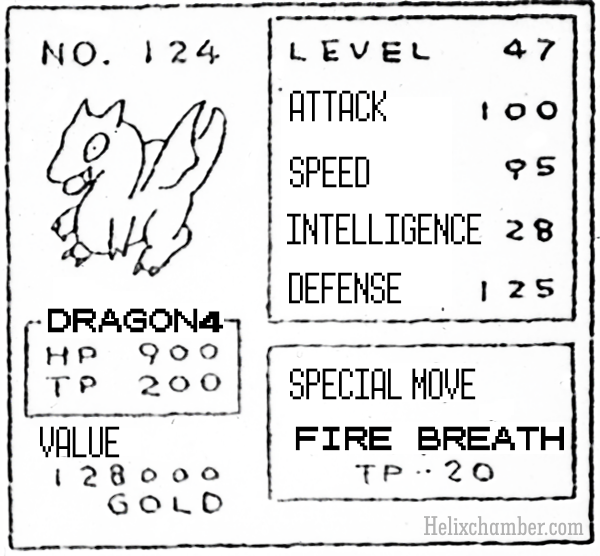
Even the final Move ID list seems to have been perfected in this period as it aligns with Period 2a Pokémon, probably replacing a fairly different pre-existing Capsule Monster move list based on different stats and a totally different HP/PP method. This earlier system can be seen in the Dragon4 mockup stats screen from the 1990 pitch. Specifically: Pound, Karate Chop and Double Slap (1, 2, 3) are used by Chansey, Machoke and Mr. Mime (40-41-42), and the early placement of “Kicks” and the “Punches” coincide with Hitmonlee and Hitmonchan at 43 and 44.
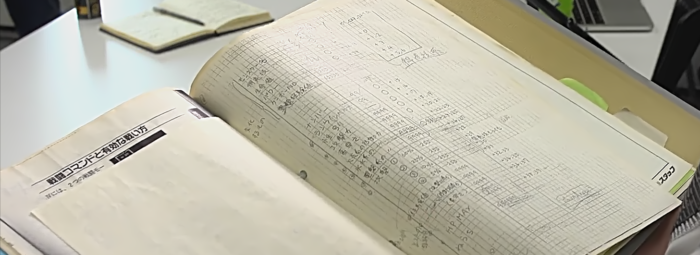
It’s easy to see the archetypal nature of our P2a monsters, perhaps still derivative of human RPG classes and tropes: Kadabra is a psychic (a nod to Yuri Geller); Graveler is a literal rock, Machoke is a bodybuilder, the Hitmons are martial artists, Mr. Mime is… a mime (although its career might’ve changed significantly, more on that in our final MissingNo. Overview), Arbok and Parasect stand out for not being bipedal players of the 2a circus, but they’re nevertheless the poster Pokémon for Poison and Bug types.
The first four Pokémon of this period are especially archetypal in regards to the battle system: Kadabra is a frail special sweeper, Machoke is a physical-oriented attacker, Graveler has high defenses, and Chansey’s main strength is incredibly high HP combined with a very good Special stat. This model translates well into battle – Chansey can’t beat Graveler with just its Normal attacks, but Machoke beats them both with ease. Kadabra beats Machoke, but struggles against Chansey and its high Special stat, while Graveler has enough punch to exploit Kadabra’s weak defenses.
Three of those Pokémon, or their evolved forms, went to become very respectable Pokémon in the Generation I metagame. The domination of Psychic and Normal-types may have begun right here.
While the first half of P2a (038-046 Kadabra – Parasect) is quite literal, mostly bipedal embodiments of their respective types, the second half (047-053 Psyduck – Electabuzz) maintains this same base concept but adds a more fantastic quality to its elementals, as they seem to be mostly inspired by legends and folklore. The Kappa inspiration is more apparent in Golduck than in Psyduck itself, but the rest of the Pokémon are inspired by Baku, Golem, Karura and Oni respectively. The empty slots at 050 and 052 might have once contained Pokémon that also adhered to those kinds of inspirations (assuming they were both reserved for actual Pokémon since one of them is misplaced or missing in the Tajiri Manga charts).
It’s important to point out that it’s not clear if double typing was already utilized. Golem might have been conceived as a pure Ground type (as its folklore inspiration is portrayed as a monster made out of clay). On that note, Golem appearing merely ten spots after its pre-evolution is something very rare in the context of the early index list, and completely unique within Period 2, as the Pokémon in this period who made the cut are all single-stage monsters. The two may not have originally been related; evolution, in general, wasn’t explored at all in P2.
Parasect too may have been either a pure Bug or Grass type. Seeing as this fundamental mechanic of the Pokémon games most likely came to be during this period, it’s important to give more attention to it. The question of which types were implemented from the start naturally arises from this. Although the answer is unknown we can briefly speculate about this subject analyzing the data currently available.
TYPES
As you know, there are fifteen types in the Generation I games, plus one unused type.
| Physical types | Special types | ||
| 0x00 | Normal | 0x14 | Fire |
| 0x01 | Fighting | 0x15 | Water |
| 0x02 | Flying | 0x16 | Grass |
| 0x03 | Poison | 0x17 | Electric |
| 0x04 | Ground | 0x18 | Psychic |
| 0x05 | Rock | 0x19 | Ice |
| 0x06 | Bird | 0x1A | Dragon |
| 0x07 | Bug | ||
| 0x08 | Ghost |
Bird-type is notoriously randomly assigned to all the MissingNo., and it clearly was merged with Flying-type to some extent. One hint at the relation (or difference) between them is that most, if not all, of the Flying moves in the game, imply that a bird is meant to use them (Wing Attack, Drill Peck, even Mirror Move and Sky Attack have bird references in their original Japanese name being respectively “Parrot Mimicry” and “God Bird”), while attacks that are clearly related to the element of wind are instead Normal type (Gust, Razor Wind).
What this could mean is that the Flying type was originally associated with wind, but most of its moves were reassigned to Normal, while Flying inherited all Bird type moves in return; of course, this is just speculation, but something to consider nonetheless.
Another thing of note is that the Ghost type and Dragon type are both last in their respective categories. Both have only three Pokémon each, and moves of both of these types are placed relatively late in the move ID list. Also, the Ghost type trainer classes are clearly a later addition to the Trainer list. This suggests us that, although literal Ghosts and Dragon monsters appeared among the first 80 Pokémon, Ghost and Dragon types weren’t initially considered, and these Pokémon – Dragonite, Gastly and Gengar – might have been retyped during development.
Seeing as there were no types before P2, Period 1 Pokémon may have been assigned types retroactively during this period. As we mentioned in the previous article, many of the early Pokémon have enormous TM learning capabilities, suggesting that they were originally typeless and that their typing remained uncertain, even when the new moves were added. Many of them were given Poison and Water types, hence the high number of these types in Generation I.
We must also note that, despite the bug-catching inspiration, surprisingly we may assume that the Bug type could’ve also been a later addition. There seem to be just 2 bug-inspired monsters in the entire P2 roster: Parasect and Venomoth. Both of them could have been re-typed later, Venomoth being just Poison, while Parasect just Grass. Also, the P1 bugs (Pinsir and Scyther) might’ve initially been assigned a different type, Pinsir, in particular, being fit for a Fighting type, judging by the lore of the Japanese stag beetle.
Back to P2a: although Fighting and Psychic types are represented more than the other ones, it still seems that some kind of balance was sought during the creative process. Not counting Dragon, Bird and Ghost types, only three of them are missing: Ice, Flying and possibly Grass (see our Parasect note above). This could further point us to the types originally assigned to the deleted Pokémon that occupied the spots 050 and 052. There are plenty of Grass and Flying types in Period 1 though, and that might have factored into their absence. Still, the Fire-Ice-Electric triad is so common in Japanese role-playing games that it’s impossible to imagine a set of elemental demons without one of those types.

PERIOD 2b
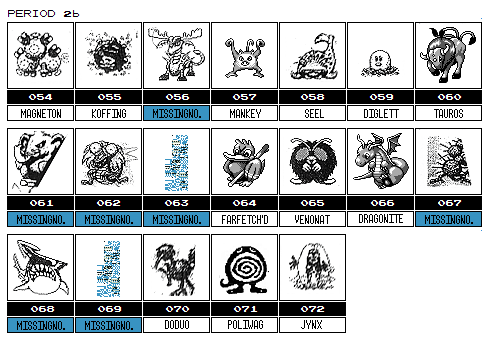
Period 2b (ID 054-072, Magneton – Jynx) adds more creatures with a clear typing. It starts with Koffing and Magneton, which are quite literally abstract manifestations of their elements, and at the same time a callback to the mimic Pokémon of P1. There is a bit more originality behind them then Voltorb and Grimer, though. Curiously, a recent interview with designer Ken Sugimori describes the birth of Magnemite as the first inorganic Pokémon instead of Magneton.
Sugimori: I suppose the first example of using an inorganic object for a Pokémon’s motif must have been Magnemite, in Pokémon Red and Pokémon Green. That was an idea that the games’ director Satoshi Tajiri thought up. On the work order, he’d just written something like: “A magnet Pokémon” (Laughs) then I designed it.
The primary direction the creators had in mind for Period 2b is to populate the environment with fitting and “credible” creatures, more resembling actual animals than creatures of folklore, a departure from the earlier mostly humanoid concepts. Double typing is, again, not directly deducible from the sources, as Seel might’ve been a representation of just the Ice type.
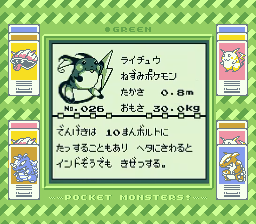 This relatively large group of Pokémon can be broken up into further patterns – as mentioned, Magneton and Koffing are a callback to the mimics of P1a, literal manifestations of their respective types and floating dwellers of the modern, industrial habitats. After that, 056-061 are Pokémon inspired by mammals, including two Pokémon that we didn’t know before the Satoshi Tajiri manga: Deer, and a Pokémon based on an elephant, perhaps posthumously amended into the “Indian elephant” (インドぞう) mentioned in Raichu and Gastly’s Pokédex entries in Pokémon Green.
This relatively large group of Pokémon can be broken up into further patterns – as mentioned, Magneton and Koffing are a callback to the mimics of P1a, literal manifestations of their respective types and floating dwellers of the modern, industrial habitats. After that, 056-061 are Pokémon inspired by mammals, including two Pokémon that we didn’t know before the Satoshi Tajiri manga: Deer, and a Pokémon based on an elephant, perhaps posthumously amended into the “Indian elephant” (インドぞう) mentioned in Raichu and Gastly’s Pokédex entries in Pokémon Green.
Crocky at 062 seems to start the pattern of comedic, often subversive monsters that seem to be the signature of Morimoto’s design. This might end either on Dragonite or Cactus – we would know better if we saw their entire sprites in the manga, of course. Jagg the shark seems to adhere to a different design philosophy, that of ferocious monsters, and the cry of MissingNo. 069 (identical to Zubat’s) might suggest a creature designed with similar characteristics (also considering a singularity in Zubat’s pattern, more on that later). The last three Pokémon may also fall into a certain design pattern, but it’s presently unknown, and they seem to be miscellaneous additions.
P2a Pokémon are mostly dungeon and cave-dwellers, while P2b Pokémon populate the many roads of Kanto (which we know had a map very similar to the final game as early as 1990). Analyzing this batch of monsters might allow us to get a speculative glimpse at the early Kanto habitats.
Many Pokémon you can find in the Safari Zone are placed among the first 80 (P1 and P2) which, considering that the Safari Zone seems to be a containment area for Pokémon the creators liked enough to keep in the game but couldn’t find a feasible native environment for, might mean they lost their original habitat at some point, and that early Kanto, despite having the same layout since the beginning, used to be a fairly different place habitat-wise, perhaps still similar to the Capumon landscape we’ve seen in P1.
Koffing and Magneton might suggest that the Power Plant was already a location, along with some sort of toxic environment (perhaps it originated as a nuclear power plant?). Cactus might hint at the fact that the desert visible in proto-Kanto was still a location in P2.
Designers seem to have balanced the types in P2b even more than in the previous one. We don’t know for sure what types the MissingNo. had, but we can be sure that Cactus was a Grass type monster (seeing how otherwise they’re completely absent in P2b), and Jagg was a Water type beyond any doubt. Considering that, and once again not counting Ghost, Dragon, and Bird types, the missing ones are Rock and Fire types.
Seeing how dragons seem to be associated with fire, it wouldn’t be a stretch to assume that Dragonite was originally a Fire type also considering that Dragon4, the placeholder Capumon we’ve seen above, had a move called “Fire breath“.
As for the Rock type, Crocky might be an odd choice to suggest, but that monster might’ve been inspired somewhat by the basilisk, gorgons, and Medusa – all legendary creatures that kill or petrify with sight. Crocky’s defining features are its big eyes, so it’s easy to imagine that the paralyzing move Glare would have been in its movepool. Then again, Crocky would then probably be the frailest-looking Rock type in existence.
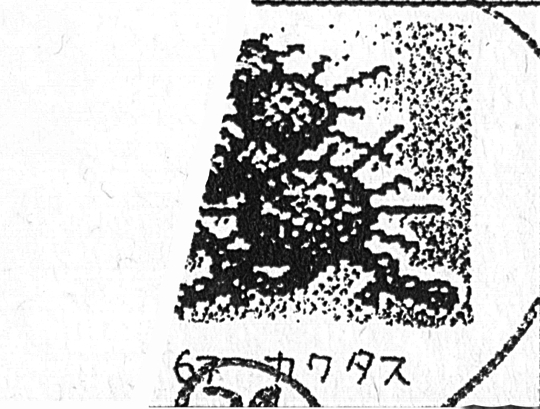
|
Prior to Cactus being revealed, one could anticipate a Grass-type being among the MissingNo. of this period because this type is so rare in P2, Cactus fulfills the missing Grass-type realistic common Pokémon prediction. It’s also the first MissingNo. listed to have a cry, shared with small, spiky monsters like Nidoran M and the desert-dwelling Sandshrew family. By the same reasoning, a Fire type could lurk behind one P2b MissingNo. With this, could a Fire fauna be the vestige of a lost volcanic environment? |
PERIOD 2c
We differentiate a third pattern P2c for the legendary birds alone because it’s the moment when the creators might have clearly first experimented with dual-typings, and Bird type would be fitting as their second type. Also, this might be the time when Gyarados and Arcanine lost their “Mirage” status.
PERIOD 2d
We separate this pattern from the other ones, because, as was stated by Akihito Tomisawa, during the first-ever Popularity poll held in October 1992, Meowth did not yet exist. Although the author also claims that there were already 80 Pokémon, he might’ve rounded the number up. These last Pokémon indeed feel like a slightly later addition anyway, adding more real-life inspired creatures that could fit into P2b plus the first users of gimmicky moves, maybe for testing purposes (Transformation, Pay Day). This is uncertain though because Transformation is placed very late in the move ID list, while Pay Day is placed very early. As such, this minor pattern remains differentiated mostly on chronological grounds, as it’s difficult to discern any concrete design philosophies that went into the creation of these monsters.
Bringing up Bird type is interesting at this point because of Barunda, which looks to have been the first airborne, flying Pokémon that couldn’t possibly be a Bird-type. It’s possible that Barunda’s creation as a non-avian, airborne Pokémon was the catalyst to delete Bird type and merge it, at least partially, with Flying type.
Sadly, the Tajiri manga didn’t reveal the identities of MissingNo. 079 and 080, and the eclectic nature of this pattern leaves few patterns to make any guesses from. MNo. 079 shares its base cry with the Rattata line, which could suggest that a small animal originally occupied this spot.
PATTERN SUMMARY
Period 2 Pokémon follow one clear general direction, which is adding typing to the gameplay. Double typing might have appeared with the creation of the legendary bird trio.
- Pokémon designed by Sugimori, Morimoto and Fujiwara with Tajiri’s direction.
- Single stage Pokémon – most of the Pokemon are still single-stage at this point and there are no three-stage lines. The only exception could be Graveler/Golem, but their evolutionary relation might not have existed at this point. So even Pokemon currently in evolutionary lines were not necessarily meant to have one.
- P2a – Elemental bipedal embodiments and battle archetypes – Pokémon created with the idea of embodying a specific type or a battle role. This results in a group of fantastic creatures with humanoid features (Arbok and Parasect are exceptions in this sense).
- P2a – Yokai and Folklore inspired
- P2b – Elemental Ecosystem animal fauna – Pokémon created to populate the environment, this time with a peculiar attention to typing. Most of them are inspired by real-life animals.
- P2c – Double typing and legendary birds
- P2d – Tests, gimmicks, and general additions.
P2 MYSTERIES
MR.MIME DOESN’T MATCH THE DOTS…?
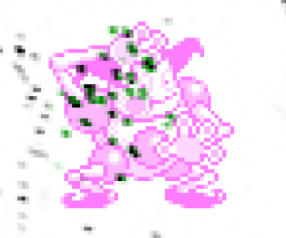 Since Baririina was among the circled Pokémon, those dots are likely to be all over the place. Some of them do seem to align with some of Mr. Mime’s features, especially the mid/lower section. There’s something different going on in its shoulders and upper part of the arm and possibly the horns. The left hand, horns, and shoulders were different, or shaded differently, with darker hues and the leftover dots above its head and in the left part of the circle. However, there seem to be more dots than needed. Some of them could be either artifacts, or remnants of the circle and the circled number. A singularity in Mr. Mime’s move learnset might suggest this Pokémon actually went through some intensive re-working, more on that in P4.
Since Baririina was among the circled Pokémon, those dots are likely to be all over the place. Some of them do seem to align with some of Mr. Mime’s features, especially the mid/lower section. There’s something different going on in its shoulders and upper part of the arm and possibly the horns. The left hand, horns, and shoulders were different, or shaded differently, with darker hues and the leftover dots above its head and in the left part of the circle. However, there seem to be more dots than needed. Some of them could be either artifacts, or remnants of the circle and the circled number. A singularity in Mr. Mime’s move learnset might suggest this Pokémon actually went through some intensive re-working, more on that in P4.
There are a bunch of sprites which don’t look like they were made by any credited artist, and seem to have been rather hastily scaled down. In these cases, the original sprites were resized when a Pokémon got an evolution. The 1993 poll confirmed this theory, as the sprites of Venonat and Krabby were much larger than in the final game. Most of these sprites were already pretty blatantly rescaled even before we had evidence. Some others were at least polished after being resized, like Venonat.
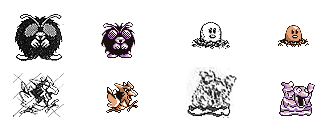
We tried to spot other re-scaled sprites without an evolution to uncover a missing link, but sadly there aren’t any, hinting at the fact there are no scrapped second or third stages among the MissingNo. However, the sprites could’ve been adjusted after their size changed, obscuring the fact that they had been shrunk down (like Venonat or Krabby). Game Freak could have also restored the original bigger sprites when they scrapped the corresponding evolution. Here is a list of Pokémon that were scaled, in order of plausibility:
Confirmed: Nidoran F, Nidoran M, Clefairy, Spearow, Grimer, Diglett, Mankey, Doduo, Krabby, Venonat, Poliwag, Poliwhirl
Possible: Meowth, Shellder (Shellder’s final sprite shows signs of being scaled down, but no older sprite exists at the moment)
Speculative: Tentacool, Cubone, Slowpoke, Pidgey.
THE NPC POKÉMON
One last note about Period 2 as a whole: most of the overworld Pokémon – the ones that appear as NPCs you can interact with – come from this period.
We tried to analyze the onomatopoeias for their cries to look for discrepancies and replaced MissingNo. There’s nothing noteworthy, but there are some oddities, which of course could just originate from the humorous nature of the interactions. Here’s a table that summarizes the results.
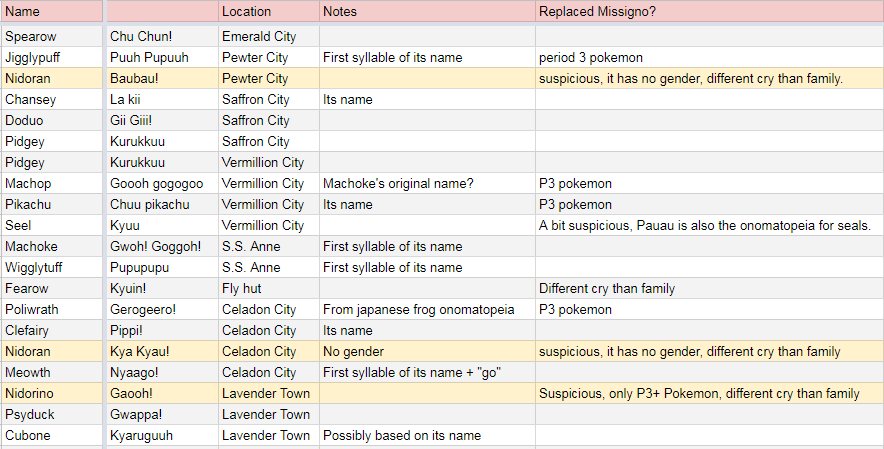
Also, this could suggest that most of the p2 NPCs made it to the final version.
NOTES, SOURCES AND MEDIA
INTERVIEWS WITH THE CREATORS
- GameInformer Pokémon dossier and video interviews with Ohmori and Masuda.
- Iwata Asks, with Morimoto and Ishihara.
- Nintendo.co.jp interview with the creators (JP) and Glitterberri’s translation.
BOOKS AND OTHER MEDIA
- ゲームフリーク ―遊びの世界標準を塗り替えるクリエイティブ集団, by Akihito Tomisawa
- Shogakukan, Manga Special about the life of Tajiri Satoshi.
OTHER RESEARCHES
- Glitterberri’s dossiers about Capsule Monsters and the genesis of the Pokémon games.
- http://arukuukura.blog.fc2.com/ (JP)
| ⇐ | INTRO | P1 | P2 | P3 | P4 | P5 | ⇒ |
| MissingNo. OVERVIEW | LOST POKÉMON OVERVIEW | ||||||
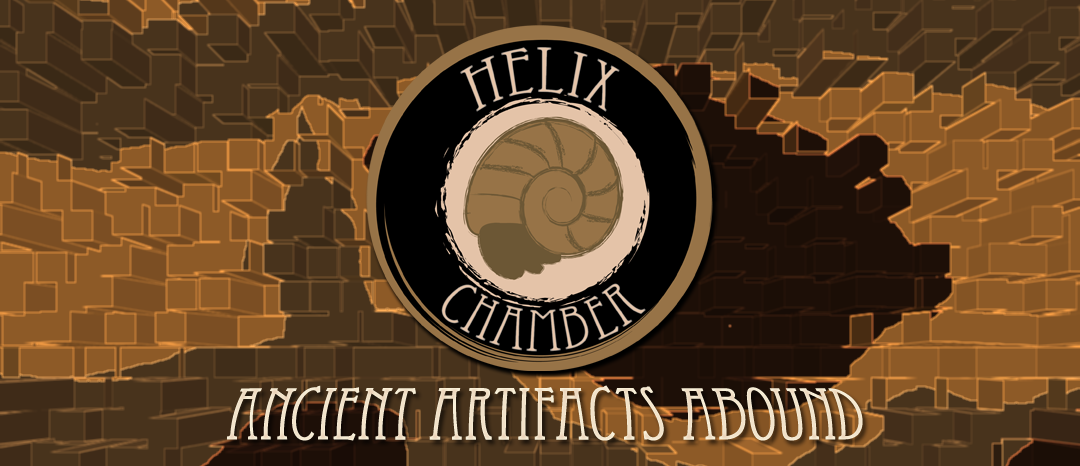




There’s nothing displayed below “Here’s a tab that summarizes the results” (did you mean table?).
Also, there’s no recap of what Pokémon were part of P2c (although it’s implied that it’s just the legendary birds) and P2d (I have literally no idea what Pokémon were in that part without going back and checking the intro), and while you talk about sprites being downsized, you don’t actually explain what about these sprites suggests they were downsized (I have some idea because I do pixel art, but will the average reader?).
These articles are really interesting, but they could really benefit from a thorough proofreading by someone who doesn’t already know what you’re talking about, who could point out this sort of thing and help you make sure the information makes sense as it’s presented. I think I’m pretty well-versed in Pokémon and am reading these articles in order, but despite that I find myself repeatedly stumbling and getting lost as I read, where the train of thought makes some strange unexplained jump. It’s a shame because this is such great material.
hey! you’re right that was actually one of our concerns, just keep pointing out the inconsistencies if you like and we’ll try to make it even more thorough, in the meantime we hope the other readers will also let us know what they don’t understand. Hopefully, we’ll get it proofread soon 😀 it is a research that is bound to be expanded/changed several times after all! Cheers! Thanks for reading
Sneasel always seemed like an obvious candidate por 052 for me, it’s bipedal, ice-type and folklore-based. No idea on why it was scrapped through, maybe they weren’t satisfied with its design, seeing its massive changes it suffered between the Spaceworld demo and GS.
I personally – not speaking for the entire team, Louminosus here- also thought Sneasel was a candidate for the ice yokai, but I changed my mind when I saw its gold demo design and placement 😮 we’ll see 😀 thanks for reading.
Quick theory: perhaps the elephant Pokemon was meant to be named “Tusk” aka “Ta-Su-*KO*”, named after the body part it just so happens to have four of. Many of the other Missingno. from this period have similarly romaji-derived names (Deer, Crocky, Cactus), so it’s not too out-there.
Hello World!
Woops, didn’t mean to do that, sorry ^^’